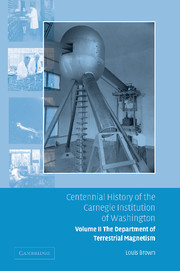Book contents
- Frontmatter
- Contents
- Foreword by Richard A. Meserve
- Preface
- 1 Establishment
- 2 Cruises and war
- 3 Expeditions
- 4 Measurements: magnetic and electric
- 5 The Fleming transition
- 6 The last cruise
- 7 The magnetic observatories and final land observations
- 8 The ionosphere
- 9 Collaboration and evaluation
- 10 The Tesla coil
- 11 The Van de Graaff accelerator
- 12 The nuclear force
- 13 Fission
- 14 Cosmic rays
- 15 The proximity fuze and the war effort
- 16 The Tuve transition
- 17 Postwar nuclear physics
- 18 The cyclotron
- 19 Biophysics
- 20 Explosion seismology
- 21 Isotope geology
- 22 Radio astronomy
- 23 Image tubes
- 24 Computers
- 25 Earthquake seismology
- 26 Strainmeters
- 27 The Bolton and Wetherill years
- 28 Astronomy
- 29 The solar system
- 30 Geochemistry
- 31 Island-arc volcanoes
- 32 Seismology revisited
- 33 Geochemistry and cosmochemistry
- 34 The Solomon transition
- 35 The support staff
- 36 Epilogue
- Notes
- Index
4 - Measurements: magnetic and electric
Published online by Cambridge University Press: 06 January 2010
- Frontmatter
- Contents
- Foreword by Richard A. Meserve
- Preface
- 1 Establishment
- 2 Cruises and war
- 3 Expeditions
- 4 Measurements: magnetic and electric
- 5 The Fleming transition
- 6 The last cruise
- 7 The magnetic observatories and final land observations
- 8 The ionosphere
- 9 Collaboration and evaluation
- 10 The Tesla coil
- 11 The Van de Graaff accelerator
- 12 The nuclear force
- 13 Fission
- 14 Cosmic rays
- 15 The proximity fuze and the war effort
- 16 The Tuve transition
- 17 Postwar nuclear physics
- 18 The cyclotron
- 19 Biophysics
- 20 Explosion seismology
- 21 Isotope geology
- 22 Radio astronomy
- 23 Image tubes
- 24 Computers
- 25 Earthquake seismology
- 26 Strainmeters
- 27 The Bolton and Wetherill years
- 28 Astronomy
- 29 The solar system
- 30 Geochemistry
- 31 Island-arc volcanoes
- 32 Seismology revisited
- 33 Geochemistry and cosmochemistry
- 34 The Solomon transition
- 35 The support staff
- 36 Epilogue
- Notes
- Index
Summary
When Louis Bauer began his plan to map the magnetic field of the Earth accurately there were only two observational methods applicable to land or sea surveys, both clumsy and inaccurate compared with modern techniques. A measurement consisted of determining the direction of the three components of the field and its magnitude. In practice this meant obtaining the deviation of the horizontal field from true north, called the declination, and the angle the field makes with the horizontal, called the inclination. Declination was determined by comparing the direction indicated by a compass with true north determined by an astronomical observation. (The horizontal measurement in fact measured two components: a north and an east–west component.) The inclination was measured by a dip circle, a magnet so balanced in the plane defined by the compass direction that the angle could be read. The compass and dip circle had various forms and were, of course, made to the highest standards of the time. For the first few years these instruments were all purchased from various manufacturers, often according to Bauer's instructions. Later the Department made its own versions (Fig. 4.1).
True north was determined using the well-developed techniques of celestial navigation, and for these data to have any meaning they had to be associated with simultaneous determinations of the station's latitude and longitude.
- Type
- Chapter
- Information
- Publisher: Cambridge University PressPrint publication year: 2005



